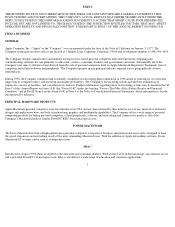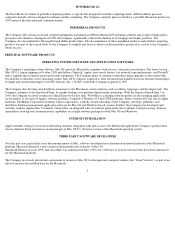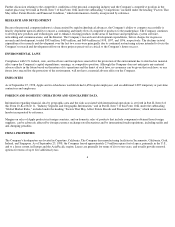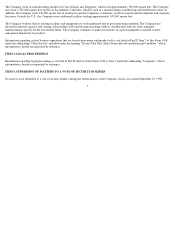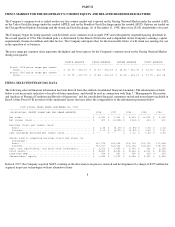Apple 1998 Annual Report Download - page 6
Download and view the complete annual report
Please find page 6 of the 1998 Apple annual report below. You can navigate through the pages in the report by either clicking on the pages listed below, or by using the keyword search tool below to find specific information within the annual report.whether there is a need for additional suppliers. In situations where a component or product utilizes new technologies, there may be initial
capacity constraints until such time as the suppliers' yields have matured. Components are normally acquired through purchase orders, as is
common in the industry, typically covering the Company's requirements for periods from 60 to 120 days. However, the Company continues to
evaluate the need for a supply contract in each situation.
If the supply of a key single-sourced component to the Company were to be delayed or curtailed or in the event a key manufacturing vendor
delays shipment of completed products to the Company, the Company's ability to ship products in desired quantities and in a timely manner
could be adversely affected. The Company's business and financial performance could also be adversely affected, depending on the time
required to obtain sufficient quantities from the original source, or to identify and obtain sufficient quantities from an alternate source. The
Company believes that the component suppliers and manufacturing vendors whose loss to the Company could have a material adverse effect
upon the Company's business and financial position include, at this time: IBM Corporation, Motorola, Inc, Canon, Inc., Matsushita, Samsung
Electronics, Alps Electronics, Logitech, OPTi, Inc., ATI Technologies, Inc., Quanta Computer, Inc., NatSteel Electronics PTE Ltd., Singapore
Technologies PTE Ltd., Jabil Circuits Inc., and LG Electronics. The Company attempts to mitigate these potential risks by working closely
with these and other key suppliers on product introduction plans, strategic inventories, coordinated product introductions, and internal and
external manufacturing schedules and levels. The Company believes that many of its single-source suppliers, including most of the foregoing
companies, are reliable multinational corporations. The Company also believes most of these suppliers manufacture the relevant components in
multiple plants. The Company further believes that its long-standing business relationships with these and other key suppliers are strong and
mutually beneficial in nature.
The Company has from time to time experienced significant price increases and limited availability of certain components that are available
from multiple sources. Any similar occurrences in the future could have an adverse affect on the Company's operating results.
Further discussion relating to availability and supply of components and product may be found in Part II, Item 7 of this Form 10-K under the
subheading "Inventory and Supply" included under the heading "Factors That May Affect Future Results and Financial Condition," and in Part
II, Item 8 of this Form 10-K in the Notes to Consolidated Financial Statements at Note 10, "Concentrations of Risk," which information is
hereby incorporated by reference.
PATENTS, TRADEMARKS, COPYRIGHTS AND LICENSES
The Company currently holds rights to patents and copyrights relating to certain aspects of its computer and peripheral systems. In addition, the
Company has registered, and/or has applied to register, trademarks in the U.S. and a number of foreign countries for "Apple", the Apple
silhouette logo, the Apple color logo, "Macintosh", and numerous other product trademarks. In 1986, the Company acquired ownership of the
trademark "Macintosh" for use in connection with computer products. Although the Company believes that the ownership of such patents,
copyrights, and trademarks is an important factor in its business and that its success does depend in part on the ownership thereof, the Company
relies primarily on the innovative skills, technical competence, and marketing abilities of its personnel.
Because of technological changes in the computer industry, current extensive patent coverage, and the rapid rate of issuance of new patents, it
is possible that certain components of the Company's products may unknowingly infringe existing patents of others; although, the Company is
not aware of any such instances currently. The Company has from time to time entered into cross-licensing agreements with other companies.
4



